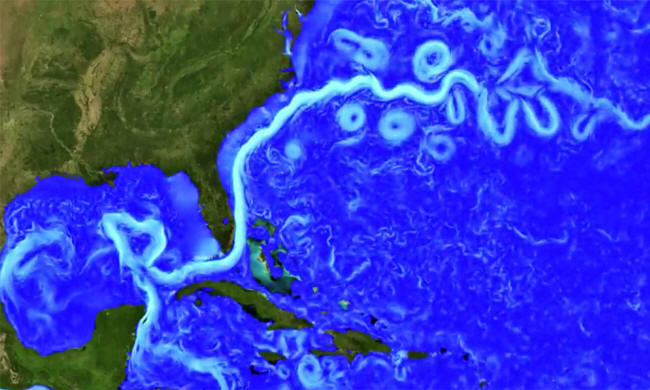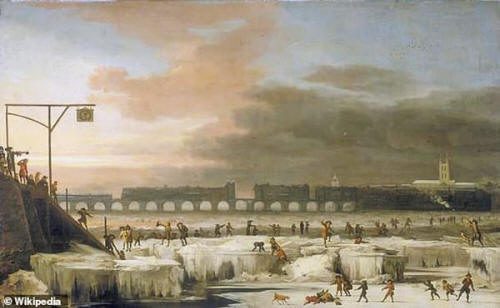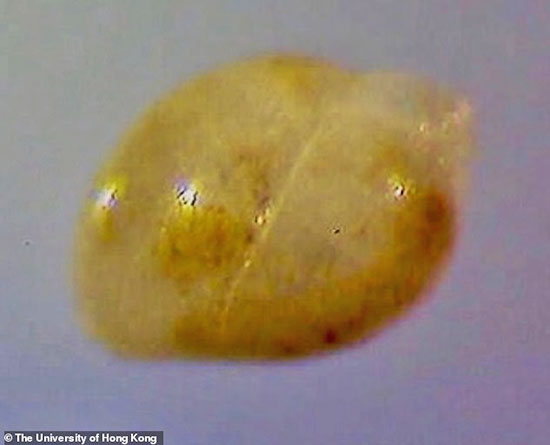|

by Mark Prigg
November 26,
2018
from
DailyMail Website

Study shows the
levels are
at their lowest
for 1,500 years.
Currents have a 'profound effect' on both
North American
and European climate.
Researcher found a similar weak signal
during a period
called the Little Ice Age,
a cold spell
observed between about
1600 and 1850
AD.
Global Warmists are in total denial, claiming that
it is really global warming that is causing
dislocations in the weather.
Technocrats who live by their science will
eventually be crushed by it.
Source
Ocean circulation in
North Atlantic is at its weakest for 1,500 years
...and at levels that
previously triggered a mini Ice Age, study warns
Researchers have
discovered that water in the North Atlantic has 'dramatically
weakened.' The study shows the levels are at their lowest of for
1,500 years - and climate change is to blame.
Researchers warn the currents will have a 'profound effect' on both
the North American and European climate.

The
weakening ocean: This is a schematic of the
circulation in the western North Atlantic during
episode of strong (left) and weak (right)
westward transport of the Labrador Current (LC).
The
oceanography of this region is characterised by
the interaction of water masses formed in the
Labrador and moving westward (LC and Labrador
Sea Slope Water (LSSW)) and the water masses
moving eastward originating as the Gulf Stream
(GS) and its Atlantic Temperate Slope Water (ATSW).
The exact
location where these two water mass systems meet
(yellow dashed lines) is determined by the
strength of the northern recirculation gyre
(white arrows), which then control the
temperature.
Researchers studied the
Atlantic Meridional Overturning Circulation (AMOC),
the branch of the North Atlantic circulation that brings warm
surface water toward the Arctic and cold deep water toward the
equator.
The research, co-led by Drs. Christelle Not and Benoit
Thibodeau from the Department of Earth Sciences and the
Swire Institute of Marine Science,
The University of Hong Kong, is interpreted to be a direct
consequence of global warming and associated melt of the Greenland
Ice-Sheet.
WHY ARE OCEAN CURRENTS SO IMPORTANT?
Ocean currents play a critical role in regulating the
planet.
Slower circulation in the North Atlantic can yield
profound change on both the North American and European
climate but also on the African and Asian summer monsoon
rainfall.
This transfer of heat and energy not only has direct
influence on climate over Europe and North American but
can impact the African and Asian monsoon system through
its effect on sea surface temperature, hydrological
cycle, atmospheric circulation and variation in the
intertropical convergence zone.
Slower circulation in the North Atlantic can yield profound change
on both the North American and European climate but also on the
African and Asian summer monsoon rainfall.
'The AMOC plays a
crucial role in regulating global climate, but scientists are
struggling to find reliable indicators of its intensity in the
past.
'The discovery of this new record of AMOC will enhance our
understanding of its drivers and ultimately help us better
comprehend potential near-future change under global warming'
said Dr. Thibodeau.
The research team also
found a weak signal during a period called the
Little Ice Age (a cold spell
observed between about 1600 and 1850 AD).
WHAT WAS THE LITTLE ICE AGE?

The reconstructed depth of the Little Ice Age
varies between different studies
The Little Ice Age occurred between AD 1300 and 1850.
There were two phases of the Little Ice Age, the first
beginning around 1290 and continuing until the late
1400s.
There was a slightly warmer period in the 1500s, after
which the climate deteriorated substantially, with the
coldest period between 1645 and 1715.
During this coldest phase of the Little Ice Age there
are indications that average winter temperatures in
Europe and North America were as much as 2°C lower than
at present.
The Baltic Sea froze over, as did many of the rivers and
lakes in Europe.

The Frozen Thames, 1677,
an original painting in the collection
of the Museum of London
Winters were bitterly cold and summers were often cool
and wet.
These conditions led to widespread crop failure, famine,
and population decline.
There were increased levels of social unrest as large
portions of the population were reduced to starvation
and poverty.
While not as pronounced as the 20th century trend, the
signal might confirm that this period was also characterized by a
weaker circulation in the North Atlantic, which implies a decrease
in the transfer of heat toward Europe, contributing to the cold
temperature of this period.
However, more work is needed to validate this hypothesis.
'While we could
ground-truth our temperature reconstruction for the 20th century
against instrumental measurement it is not possible to do so for
the Little Ice Age period.
'Therefore, we need to conduct more analysis to consolidate this
hypothesis' said Dr. Not.
The findings were
recently published in the prestigious journal Geophysical
Research Letters.
The Atlantic Meridional Overturning Circulation (AMOC) is the
branch of the North Atlantic circulation that brings warm surface
water toward the Arctic and cold deep water toward the equator.
This transfer of heat and energy not only has direct influence on
climate over Europe and North American but can impact the African
and Asian monsoon system through its effect on,
...in the
intertropical convergence zone.

Drs. Not and Thibodeau
used microfossils, called foraminifer,
found in a sediment core to estimate
the past temperature of the Ocean.
Pictured, the foraminifer specie used in this study
Many climate models
predicted a weakening, or even a collapse of this branch of the
circulation under 'global
warming,' partly due to the release of freshwater from
Greenland Ice-Sheet.
This freshwater has lower density than salty water and thus prevents
the formation of deep water, slowing down the whole circulation.
However, this weakening is still vigorously debated because of the
scarcity of long-term record of the AMOC.
Drs. Not and Thibodeau used microfossils, called
foraminifera, found in a sediment
core to estimate the past temperature of the Ocean. The sediment
core used is in the
Laurentian Channel, on the coast of
Canada, where two important currents meet.
The strength of these currents will control the temperature of the
water at the coring site which implies that the temperature
reconstructed from this core is indicative of the strength of the
North Atlantic circulation.
With their collaborators from the United-States of America, they
validated their results using instrumental data and two numerical
models that can simulate the climate and the ocean.
| 





